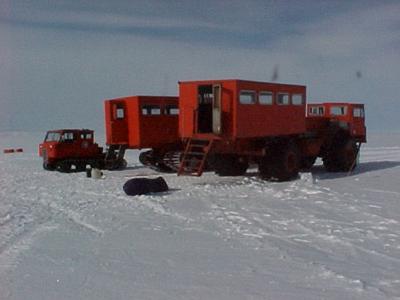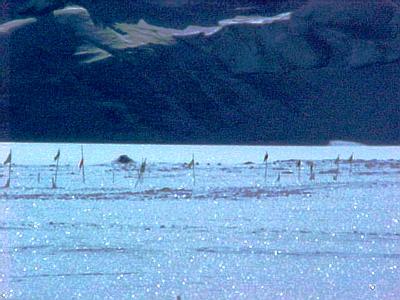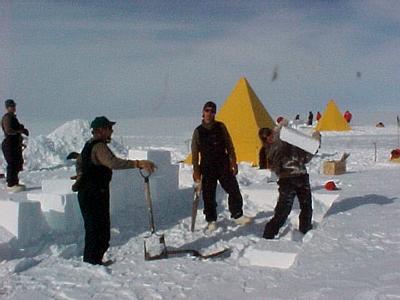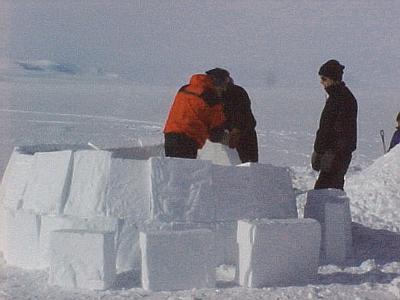
|
|
19 November, 1999
Happy Camper School
This morning I awoke on the frozen continent for the first time. The four McMurdo newcomers on our team, Barb, John L., Jack and I, went to a 9:00 a.m. briefing with John P. and various staff members from both the National Science Foundation (NSF) and Antarctic Support Associates (ASA). The meeting was meant to introduce us to some of the key people who handle daily living details(i.e.. supervisors of the Crary Lab, mechanical shop, field safety classes, waste management...) here at the base and in the field. Problem was, after fifteen minutes, one of the staff members looked at the four of us and announced, "You were supposed to be at survival school at 9:00! Why are you here?" Well, this was the first we knew of class that morning (we thought it would start later that afternoon),so off we ran to put on our ECW gear, pack our bags, collect our sleep kits and race up the hill to where the introductory lecture had already began. Once I got into the classroom, I was so overheated from racing around, I had to peel off layers of clothing to cool down. Those sweaty layers would return to haunt me later...
Field Safety Training, also known as either Happy Camper or Survival School, goes over basic survival strategies for safely living and working in extremely cold, remote conditions. The two day course covers a range of topics including anchoring tents in windy conditions, helicopter transportation, radio communications, constructing snow shelters, emergency first aid for medical conditions such as hypothermia and frostbite, safe travel in crevasse territory, use of camp stoves, risk assessment and management, and search and rescue.
Shortly after we arrived at our field training site, we were divided into two camping groups. Much of the rest of the day was spent securing tents and building a variety of shelters. As you'll see in some of the following photos, the "happy campers" took this task to heart!

These are some of the vehicles used for transportation in Antarctica. We = used the two larger ones to go the few miles out from McMurdo to the field = training camp. The one in the center with the bulldozer-like tracks is = called a Nodwell. To its right, with the monster wheels, is a Delta. The = machine on the left is the appropriately named Sprite- it's small but = quick! The larger two vehicles rumble so loudly that when you ride up = front with the driver you have to wear ear protection.

This is a view from the permanent ice shelf where we camped for the night. = The ice is part of a floating glacier approximately four hundred meters = thick. In the distance, what looks like a mountain is part of a towering = glacier that is tumbling in on itself. The snow crystals in the foreground = glittered like diamonds in the blinding sunlight. The green and red flags = mark where you can safely walk or cross country ski. Black flags signal = hidden crevasses and mean EXTREME DANGER! STAY AWAY! =

From our camp, we looked out upon the sweeping expanse of snow that is the = unnamed glacier we were stationed on. Under the cloud cover in the = distance, Mt. Erebus is belching steam.

Jack (leaning on his shovel), John (leaning on his saw) and I (doing all = the work) are cutting blocks of snow for the igloo another group of folks = is building. First, we used saws to outline the size of the blocks we = wanted to cut out. It was fun cutting through the snow with ordinary wood-= cutting saws. Next, I stuck a shovel under the block to begin to pry it up.= I was surprised at how simple it was to lift the blocks out whole without = even cracking them. (They're a lot lighter than I'm making them look.) = Even so, despite the lack of heavy strain, we were warm enough to discard = our parkas for awhile.

Igloos are much more complex shelters than snowmounds. Unlike the = miniature variety built of uniformly sized sugar cubes, this one was built = in a spiral from the ground level up. The first twelve or so blocks get = progressively thicker until you've got four or five blocks the same = thickness at the end of the first complete turn. All the blocks are then = angled towards a center point, similar to spokes on a bicycle wheel. Each = new flight of blocks are stacked slightly closer to the center. =

The most difficult building step was adding the roof. Two of the guys = worked from the inside, bracing the blocks with a temporary pillar, and = the third gave directions from outside. These three perfectionists spent = easily nine hours creating the structure that only two of them would fit = in. If this had been an actual emergency situation, they'd have been = extremely cold and totally out of luck. Fortunately, it wasn't, so they = were able to perfect their block fitting technique. Their enormous focus = was impressive, and their first-try igloo was a beauty!

After a dinner of freeze-dried meals cooked right in the pouch, some of us went for a cold walk
along the flagged route featured in the earlier photo. These are my three hardy colleagues, Barb,
John and Jack, upon their return from climbing fourteen hundred feet from sea level to the base of
Castle Rock.

Contact the TEA in the field at
.
If you cannot connect through your browser, copy the
TEA's e-mail address in the "To:" line of
your favorite e-mail package.
|
